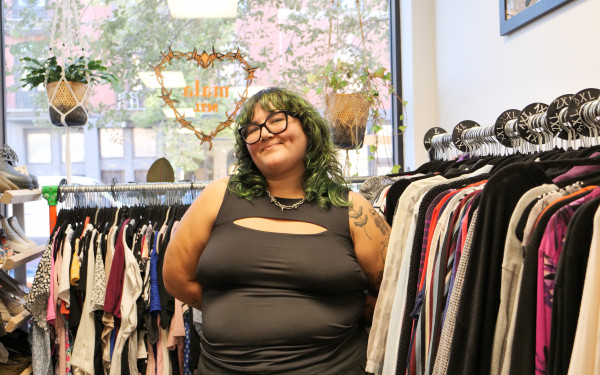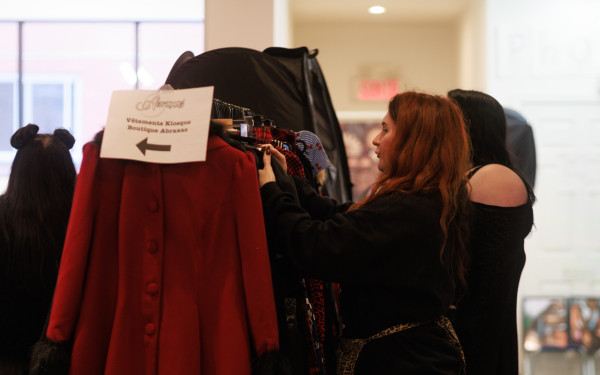The Ethics of Thrift Store Reselling
Gentrification or Responsible Consumption?
Vintage band tees and Levi’s are piling up in the closets of Montreal residents, yet some have deemed these purchases unethical.
What was previously a resource for low-income people has now become the trendiest form of shopping in Montreal. Thrift stores are popping up all over the city, and online shops are abundant with growing clientele. The clothing resale market in North America has grown 215 per cent from 2012-2021, according to the GlobalData 2022 Resale Consumer Survey from the online consignment and thrift store ThredUp.
The upsurge of thrift shopping hasn’t happened in a vacuum; the turnover of fashion trends has increased to an unattainable pace. Valerie Belanger, VP of business relations at Concordia Fashion Business Association, looks at thrift shopping as a response to the fast-paced nature of the 21st century. “I just think it’s good for the environment because we are all products of capitalism and hyper-consumerism […] we’re conditioned to go shopping once every week, once every two weeks to feel good. So, it’s a good step to be like, ‘Okay, well if you’re going to do that, go to the thrift store’.”
This movement of secondhand shopping is driven by teenagers and young adults. ThredUp’s 2019 report stated that 46 per cent of Gen Z shopped second hand that year, as opposed to 18 per cent of Gen X. This growth is largely due to an influx in online selling. Seventy per cent of consumers say it’s easier to shop second hand than it was five years ago due to the increased online marketplace.
However, some people don’t support the movement. Curated thrift stores and online resellers–who buy the trendiest pieces at non-profit thrift stores to resell them for profit–are receiving flack. Critics have argued that they are depriving low-income people of affordable clothing by buying up the quality items.
When it comes to resellers, Belanger said, “there is so much clothing that I don’t know if it’s a big enough problem that we should be really targeting that. Let’s target [fast fashion]. Let’s talk about that. It’s kind of turning it on consumers, making it our fault instead of the larger company’s fault.”
Online outlets are the main platform for critics to voice their opinions on the practice. Often, millennials have taken to social media, specifically Twitter and TikTok, to argue the negatives of thrift shopping. Some defend their reselling of thrifted clothing as removing the stigma of second-hand clothing, others compare the practice to gentrification, pushing people out of affordable clothing options.
Many have shared concerns about the lack of size inclusivity with thrift stores. A study by Statista in May 2021 showed that 19 per cent of women’s apparel sales in the U.S. were from plus-size women, while 68 per cent of women in the U.S. are plus size. With fewer plus size garments being produced in the first place, even fewer end up in thrift stores. Those that do are often purchased by people of a smaller size. Some buy them for an oversized look or for the fabric to create a reworked garment.
ThredUp reported that 53 per cent of consumers say they choose fast fashion because it saves them time, highlighting the advantages of curated stores and making second hand shopping more enticing and accessible. “I know a lot of people think thrifting is gross or it’s so much work. So, [curated stores] are kind of a good thing,” said Belanger.
There is another crucial aspect of thrifting for young people, “It’s a form of self-expression. Especially with our generation, people are looking to stand out or express themselves, and this is definitely a reasonably priced way to do that,” Belanger explained.
Annie DeGouchee, who started selling on Depop in 2020, echoed this notion. “When I was younger, I loved clothing and expressing myself through clothes. I think I shifted to thrifting, one because of the money, but two, because fashion helped me develop another interest in sustainability.” She goes on to explain that she doesn’t thrift to sell, having started with her own clothing to make some cash on the side.
Once she ran out of her own clothes, she started shopping for pieces to resell. “I found that it was a good way to buy clothing and then not have to be wasteful with circulating through clothes so quickly.”
During the pandemic, Depop and many other resale apps saw their business boom. Depop’s gross merchandise sales went from $70 million to $650 million in 2020. Currently, Depop has 3.3 million active buyers and 1.8 million active sellers. But there is more to the resale app than making money, according to DeGouchee, there is a community aspect in which sellers make friends and connections.
When considering what makes a successful online seller, “It depends on what you define as success,” DeGouchee said, “I’m not really looking to create some sort of business […] I tend to just thrift clothing I really like and then get rid of them when I don’t want them.”
She ensures that she loves and would wear everything she purchases. If something doesn’t sell, she’s okay with it staying in her closet for the long haul. “In that sense, I think I’ve been able to stay true to my own personal style through my Depop.”
When she is shopping, DeGouchee steers clear of curated stores. Instead, her place of choice is Renaissance. The Montreal-based non-profit organization has become the go-to spot for thrifters of all backgrounds.
Renaissance was founded in 1994 by the founder of the food bank Moisson Montreal.The organization features a six-month job training program which pays participants to get trained in stores, teaches them applicable job skills, and assists them in finding long-term employment. There have been 4,583 job training participants since 1994, according to the 2021-2022 Renaissance Impact Report.
Masson said a lot of people mistake their organization as one that clothes the poor when really, they sell so their revenues can help more people, “We reintegrate profits [...] to invest in our social mission. That’s the social economy in a nutshell.”
Recently, they have been able to make great headway on their goals on account of growing income. Masson said the change is largely due to environmental concerns from the younger generation.
“The younger crowd is much more environmentally conscious. When you read the statistics, you’ll hear that the baby boomers are more environmentally aware but not very active,” Masson said. “Then there’s the 18 to 25 year olds who [...] are willing to take action because they understand that now is the time, not in 10 years.”
Overall, though, their clientele is widespread, from young families to new migrants. “It’s very eclectic and we love it,” Masson said.
However, there is more to their organization than assisting those in need. “We help people with fewer revenues, but we are an alternative to what’s happening in fast fashion,” Masson said. “We think that second hand stores need to become part of your regular shopping destination points. […] Too many usable items end up in the trash. […] It needs to be shared, given, sold, whatever, we do not throw it out.” Since 1994, Renaissance has sold 24,407 tons of secondhand items.
Massion said resellers shopping at Renaissance stores do not get in the way of their mission. “It is not going to trash, and we are selling, therefore we make revenue and we can grow our social mission. We are totally fine with that.”


_600_832_s.png)



__600_375_90_s_c1.jpg)